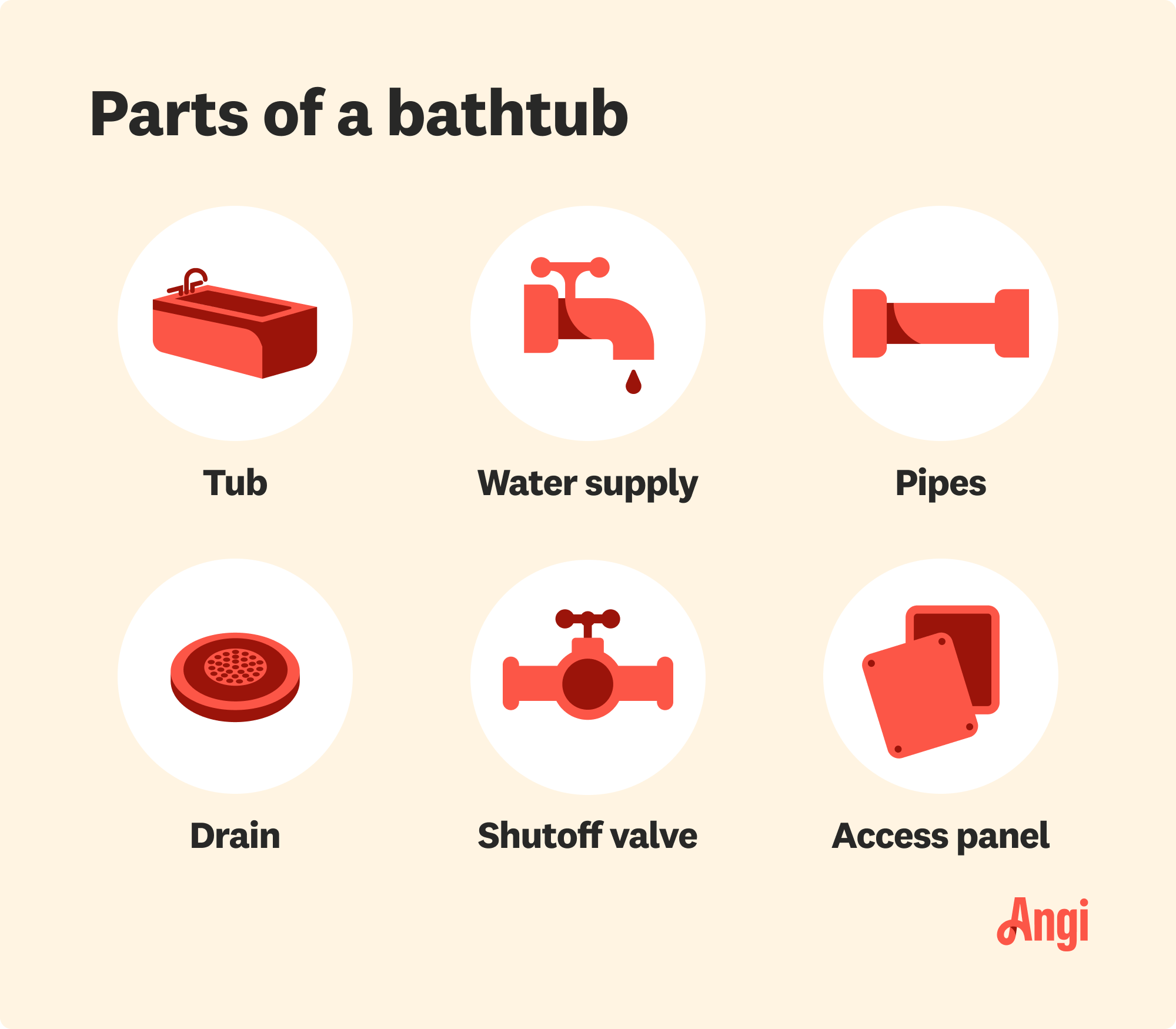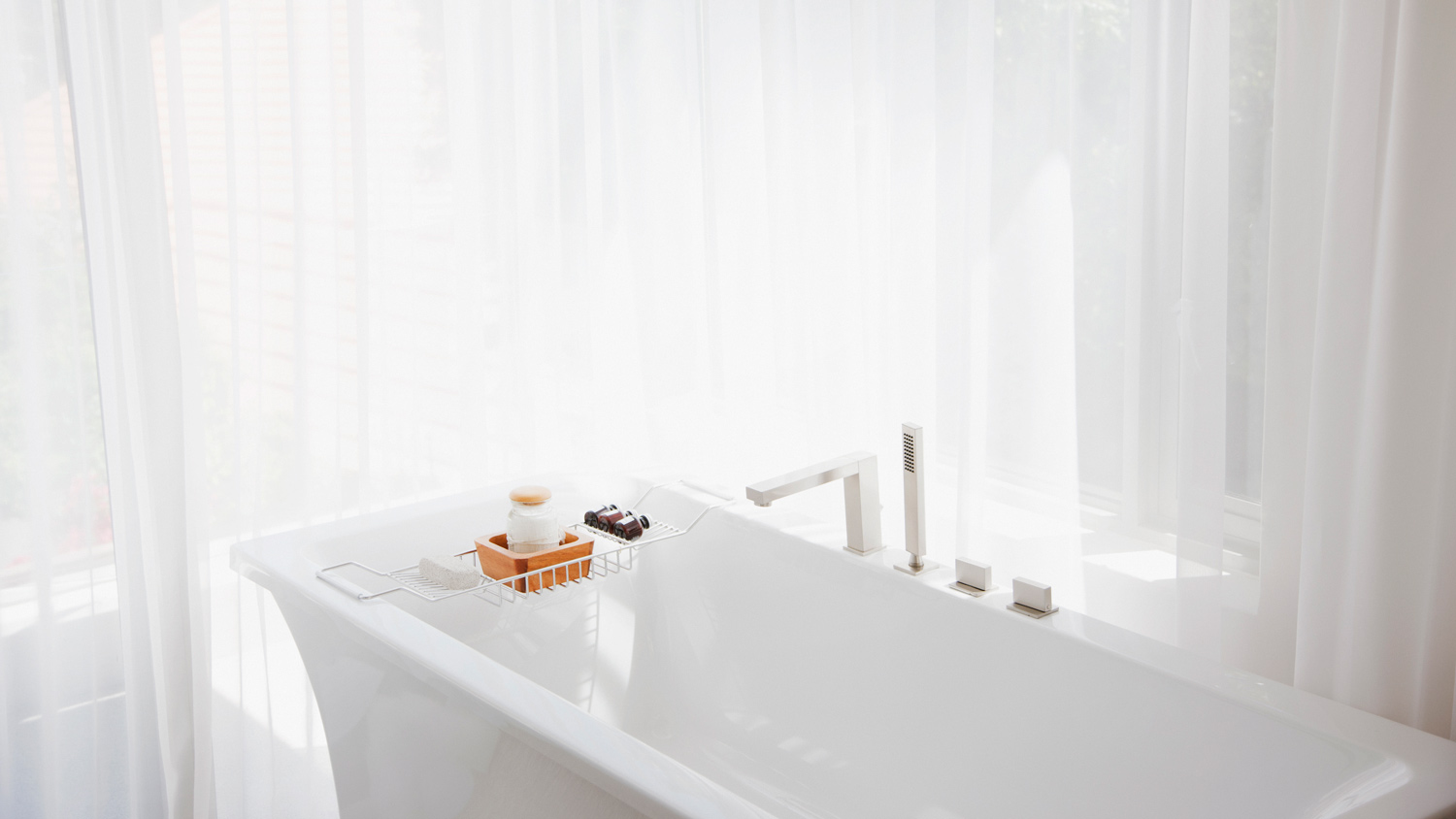
Remodeling your bathroom can add significant value to your home. Your bathroom remodel cost in Columbus, OH will depend on size, fixtures, materials, labor, and other factors.
Let’s get into the parts of a bathtub and learn how it all works


The shower, water control, tub, and drains are the most recognizable bathtub parts.
Hot and cold water supply pipes provide water to your tub.
A diverter pipe and shower control let you switch the water flow between your shower and bath.
Bathtub drains have two sections: one for wastewater and one for overflow.
Your bathtub is more than just a tub. While some tubs have fancy jets and additional features, even your most basic bathtub still has some serious plumbing work. Otherwise, we’d all be stuck bathing in barrels with buckets like they did in medieval times. Here are some key bathtub parts to know—whether you’re planning a bathtub replacement, want to fix some leaky parts, or just have an interest.

All bathtub components contribute to functionality and comfort. Most bathtubs are made of acrylic, fiberglass, or enamel-coated steel. Safety features are connected to control water flow and prevent overflow.
The tub is the part we typically think of when it comes to bathtubs. It’s the basin that fills with water. Of course, there are a few different types of bathtubs to choose from. A clawfoot tub is a free-standing tub supported by legs, whereas an alcove tub—the most common type in the United States—connects to the wall.
Tubs come in all kinds of materials at different price points. The cost of a bathtub made from fiberglass could be as low as $200, while a ceramic tile bathtub could cost as much as $10,000.
If your tub connects to the wall, it will have a tub abutment. This bathtub part directly attaches your tub to the wall and holds it in place, but you might know it as the place where you line up your shampoo and bodywash. It’s sealed with silicone caulk to make it waterproof.

The water supply is how you can control the water that enters your tub. There are a couple main parts:
Spout: Directs water into the tub
Faucet: Lets you adjust the temperature
Most faucets have a hot and cold tap connected to the correlating water supply pipes. It’s a similar configuration to your kitchen or bathroom sink. In some modern systems, you use a single lever to switch from hot to cold water from the supply lines. If you have one spout, a diverter pipe will help you get the perfect mix of hot and cold water—but that’s not always true.
In places like Europe, tubs with dual spouts are common. In this case, one spout pumps out hot water, and one pumps out cold water. Your tub may also have a hand shower (or handheld showerhead) that you can detach.
The flexible connector is the pipe connecting your bathtub drain to the wastewater system. As the name suggests, it’s flexible, making it easier to install in tight spaces than traditional rigid PVC pipes.
The water supply pipes draw water from your home’s main water line to your bathtub’s water supply, which lets you control the temperature and flow of water into your tub. Each tub has two supply pipes:
A cold water supply pipe that provides cold water
A hot water supply pipe that provides hot water
These supply lines are connected to a diverter pipe that lets both lines come out of a single spout. A cartridge valve connected to the hot water line allows you to control the temperature.
Not every bathtub has a shower, but it’s actually increasingly common for homeowners to hire a local bathtub replacement pro to rip out their tub and install a walk-in shower. Bath-shower combinations are popular for families with young children. Though there are different types of showers, they’re all made up of a few key parts of the tub:
Showerhead: This is where the water comes out. It’s either attached to your wall or attached with a flexible hose or sliding bar.
Shower control: Also known as a diverter valve or shower handle, this device rests between the showerhead and the water supply. It lets you switch the flow of water between the bathtub, shower, and (if you have one) hand shower.
Diverter pipe: This pipe carries water diverted from your bathtub spout to the showerhead.
Shower valve: The shower valve is located behind the shower control and controls the temperature and flow of water. Some valves are also pressure-balanced and can prevent dramatic temperature changes. An average shower valve costs between $150 and $550.

The wastewater drain is the drain at the bottom of your tub, located below the spout. There are three main parts in this section of the system:
Stopper: We typically think of this as the drain itself. It plugs the drainpipe so you can fill or drain your tub. It also prevents items that could clog the pipe from falling down the drain.
Waste outlet: This part of the drain system pulls wastewater into the sewer.
Trap: A trap is connected to the waste outlet to prevent harmful (or smelly) sewer gases and substances from entering your home’s water supply line.
The tub overflow drain prevents flooding when you overfill your bathtub. It’s usually on the side of the bathtub below the spout.
Faceplate: This is the face of the drain. Typically, it’s a metal cylinder.
Overflow pipe: This pipe connects to the faceplate and diverts excess water to the pipes behind the main drain, so it doesn't end up on your bathroom floor.
This is a four-cross pipe connection installed in bathtubs. It connects your water supply, the diverter pipe for your shower, and the drain, allowing water to flow from your home’s plumbing system to the different parts of your bathtub plumbing.
Some bathtubs have water shut-off valves on the water supply pipes. These should let you manually stop the flow of water into your bathtub plumbing if you need to make repairs. With some bathtubs, you’ll have to shut off the main water line to your home.
Some tubs have an access panel that easily lets you access the bathtub plumbing. Your local plumber will open this panel to make repairs, but not all bathtubs (especially alcove tubs) will have this panel.
Bathtub liners, made of acrylic or PVC, can give your old tub a brand-new look. Installing a bathtub liner is a cost-effective alternative to replacing your tub or refinishing it. Liners don’t require demolition, are molded to fit perfectly into your existing tub, and have a lifespan of up to 15 years.
If you're considering replacing your bathtub, it's essential to know that the cost can vary significantly based on several factors. Space constraints, reinforcement needs for flooring, and desired finishes mean bathtub installation costs can range from $2,000 to $9,400. Then, there's the cost of the tub to consider. Basic builder-grade models start at around $200, while a high-end clawfoot can cost you $14,000.
Whether to install it yourself or hire a bathtub installer near you depends on your DIY expertise level and the project's complexity. If you have some plumbing and carpentry skills, simple installations like replacing an old tub with a similar one might be manageable and help you save on labor costs.
However, hiring a licensed professional is best if the installation requires extensive plumbing modifications, structural adjustments, or specialized tools. Doing so will help ensure proper installation and avoid potentially costly mistakes or safety hazards.
From average costs to expert advice, get all the answers you need to get your job done.

Remodeling your bathroom can add significant value to your home. Your bathroom remodel cost in Columbus, OH will depend on size, fixtures, materials, labor, and other factors.

A brand-new pantry can free up a lot of space in your kitchen. But how much does it cost to build a pantry? This guide breaks it down.

The cost to demo a kitchen depends on its size, construction complexity, materials, and whether you DIY the job or not. This guide will help you budget better.

A bedroom remodel costs a significant amount but considering it’s often the most used room in the house, it can be a great investment. Learn where you can save money and increase your home’s value.

When comparing a steam shower versus a sauna, some factors can impact which one is best for you, including installation, temperature, treatment, and cost.

An updated bathtub can give a bathroom a whole new look. Find out how much it costs to replace a bathtub in Kansas City, MO, including prices by type and labor costs.